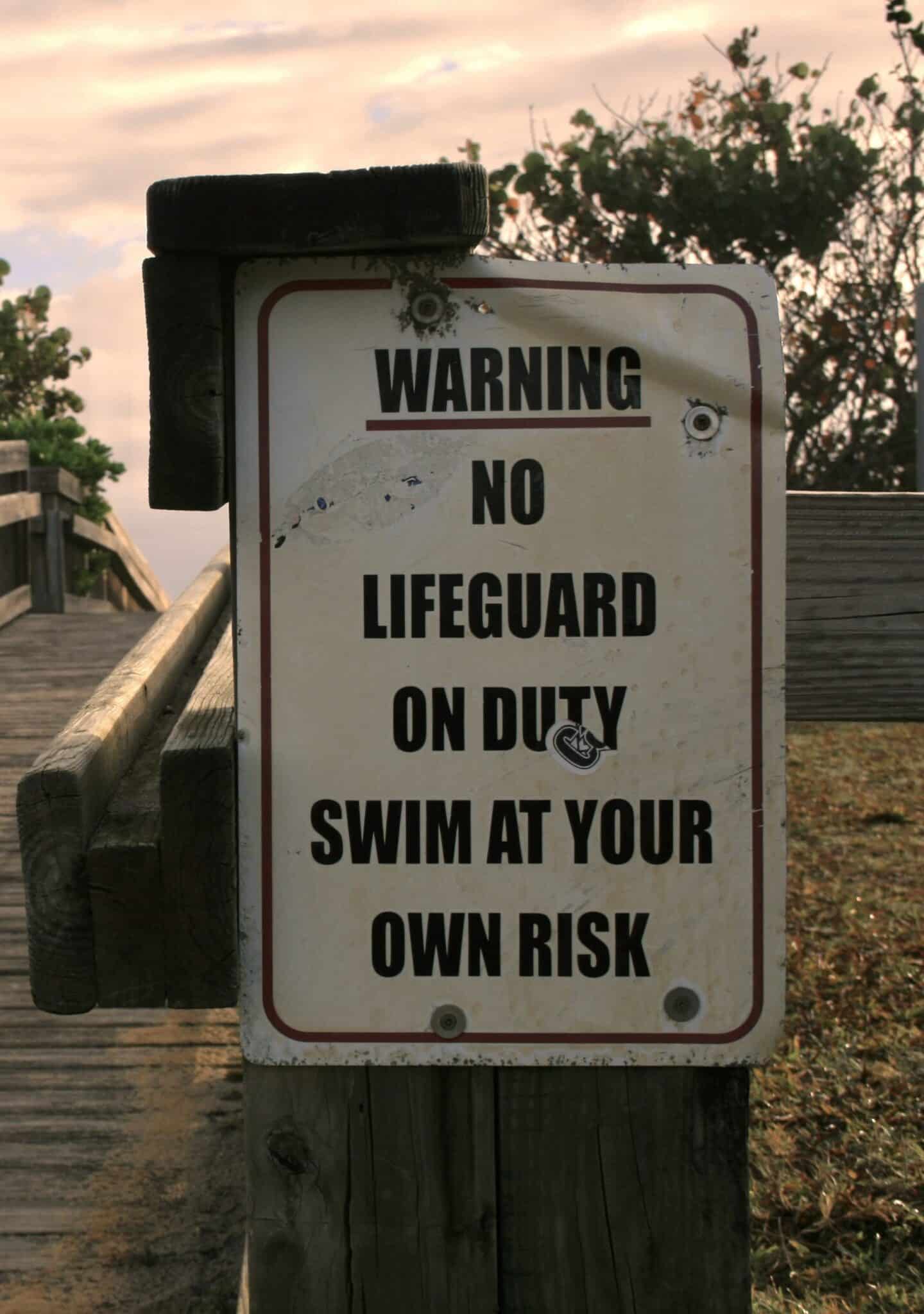How to Make Your Home Inspection Disclaimers More Effective
By Alyssa Cink
Last Updated November 9, 2023

You’re inspecting a bed-and-breakfast along a scenic river, an area known for its hardwood forests and wildlife. It’s a late-summer, late-afternoon appointment. Dusk starts to fall, and your visibility—already impacted by the tall trees overhead—diminishes even further with the fading sunlight. On top of that, you’re welcomed by gentle rainfall, lifting musky, earthy scents from wet leaves and soil underfoot. All conditions considered, you decide to start with the exterior and work your way inside before the rain gets too heavy.
You ascend your ladder and step onto the roof. It’s a metal roof, you realize. Even with your best boots, you worry the metal surface will be too slippery. You decide to play it safe. Rather than walking the entire roof, you take a few steps, snap photos, and view the rest from the ground-up. It isn’t worth a fall. And, besides some debris the next owners need to remove, the roof looks solid with no signs of leaks.
When summer turns to fall, you get a call from your former clients who purchased the bed-and-breakfast. They discovered that a large tree growing next to the house had severely bent the metal roof, causing prolonged leaking and decay to the wooden soffits and fascia. But in your report, you said the roof was in good condition. They demand to know why you didn’t report the damages.
Here’s what they don’t know: The rain and accumulation of leaves and other debris obscured your view, and you only partially walked it. You forgot to report your limited examination and its possible implications. But you took pictures. Wasn’t it obvious that you couldn’t see the entire roof?
Unfortunately, to many clients, your constraints aren’t obvious. That’s where your home inspection disclaimers come in handy.
What is a disclaimer?
You see them all the time: on exercise equipment, children’s toys, playgrounds, and even vitamins, lists LegalMatch in their disclaimer guide. In an industry as litigious as yours, home inspectors need disclaimers, too.
So, what is a disclaimer? Disclaimers are declarations you speak or write to relieve you and your business of responsibility in risky situations. According to Progressive Legal, they bring your clients’ attention to factors:
- Your business is not liable for,
- Your clients are solely responsible for,
- A third party is liable for, or
- That require additional context.
As a home inspector, you’ll likely use liability disclaimers in your pre-inspection agreements, reports, and conversations with clients.
For example, when a client receives your pre-inspection agreement, they read a definition of what’s included in that particular inspection. We call that your scope. Your scope defines the visual inspection your client is paying for, states which standards of practice (SOP) you’ll follow, and communicates everything else you’ll do and observe.
Disclaimers, by comparison, define everything outside the parameters of your scope. They tell the client, “This is what I am NOT responsible for,” or even, “As my client, this is what YOU ARE responsible for.” You can find this language among the exclusions, limitations of liability, and similar agreement clauses.
If your scope is your peanut butter, your disclaimers are your jelly. The risk management sandwich wouldn’t be complete without them.
Why Home Inspection Disclaimers Are Important
Disclaimers make it clear that you can’t see, touch, or reach everything, says Luis Chávez of Top Inspectors in Texas. This is important because frivolous claims often stem from clients having unrealistic expectations of what an inspector can do. Whether the client genuinely misunderstood your limitations or just wanted someone to blame, disclaimers can boost your defense in court.
“If you're an inspector and you don't use a disclaimer, you're opening yourself up to liability. You're opening yourself up to a possible lawsuit,” said Gary Piccarreto of GP Property Inspections LLC in New York. “In this day and age, everybody is sue-happy. Everybody wants to make a buck or get something for free. They want to get their roofs done for free because the inspector missed something on it. You can't be expected to see everything. Even though it's in the report…sometimes you need to spell things out for them.”
In addition to protecting you, disclaimers also protect your buyers, Piccarreto said. Explaining what you couldn’t inspect gives buyers an idea of what they should look for once they own the home.
For example, if you need to disclaim the living room floor due to a large couch covering it, your buyers will know to keep an extra close eye on that spot once the furniture’s removed. They may even use the foreknowledge from that disclaimer to book a re-inspection from you before they move in.
How do disclaimers differ across mediums?
Between contracts, reports, and verbal conversations, home inspection disclaimers work together toward the common goals of setting expectations and deterring claims. But in each medium, you may use them a little differently.
Pre-Inspection Agreement Disclaimers
First, let’s consider your pre-inspection agreement. Because your client is likely reading this contract before you’ve inspected the property, you won’t know exactly what to disclaim. Therefore, you’ll use your pre-inspection agreement to establish the broader limitations your client should generally expect you to face.
Note, however, that your contract won’t list every single exclusion or limitation. Rather, it should highlight the most important ones that aren’t already excluded from your SOP. Some inspection disclaimer examples include:
- What a deficiency is or is not.
- The client’s duties and everything to which they agree. For example, this could include a home inspection disclaimer stating that the service is not a warranty or guarantee.
- Conditions or requirements that are more common in certain geographic regions, like underground oil tanks in the New England states.
- If you’re offering a limited service, like a radon or roof inspection, what that service does or does not cover and any limitations related to your inspection methods.
- Liability for environmental and health conditions, like mold.
- The limitation of liability clause, which defines the maximum amount of money you’re responsible for paying if you’re found liable for a claim.
Inspection Report Disclaimers
Meanwhile, by the time you’re writing your report, any disclaimers you use should be specific to the home you inspected. When used thoughtfully, echoing limitations from your contract in your report can help clients understand your methods, findings, and recommendations.
For example, consider buried oil tanks. If you inspect homes in Maine, buried oil tanks will be more common than if you inspect homes in California. While writing your report, you might manage your risk by warning the buyers that underground oil tanks are common in your area. You would then add that detecting these oil tanks is outside your scope, and therefore, you recommend they hire a specialist to sweep the property, just in case. If you’d excluded that inspection report disclaimer, and the buyers had trouble with an underground oil tank years later, they might direct the blame to you.
We can also look back to our story from the beginning. While writing his report, the inspector said he viewed the roof covering by walking the surface, because that was his typical method. However, he forgot to disclaim that he only partially walked it. He also neglected to specify why he only walked a small portion, the alternate method he chose after, and how that might’ve impacted his visibility and findings. Although the claim ultimately closed in the inspector’s favor, disclaiming his limitation and referencing back to his SOP would’ve fortified his defense. In fact, it might’ve prevented the claim altogether.
Verbal Home Inspection Disclaimers
It’s crucial to get your pre-inspection agreement signed and echo situational limitations in your report. But what if your client signs the contract without reading it? What if you send them the report, and they don’t read that, either?
To play it safe, many home inspectors also communicate their disclaimers verbally. Chávez, for example, uses scheduling calls to answer questions about what the inspection will or will not cover. He’ll also disclaim any services he and his team are not licensed to offer, like termite inspections. This can prevent misunderstandings from clients who thought they were paying for termite or mold inspections, but just didn’t read the disclaimers while signing their contract. Furthermore, anticipating and answering questions builds trust and rapport, making it an excellent customer service tactic.
Piccarreto takes this a step further by inviting clients to attend his inspections. This isn’t ideal for every home inspector. But Piccarreto’s found that in-person chats make the message stick. Additionally, they help clients feel less intimidated about calling and asking for clarification. He’s had clients call even several years down the road.
“A lot of times, they'll call me back afterwards [and say], ‘I didn't quite get what you meant when you wrote this.’ Then I just explain it to them again. … Once I do that, they usually remember what I had said the first time,” Piccarreto said. “I always put in my reports: Call me. You can call me and ask me anything. If there's something you don't understand, something in the report, I'd rather have you call me and ask me a question than try to do something on your own and get hurt.”
How to Write and Use Home Inspection Disclaimers More Effectively
How effectively do your disclaimers set expectations with clients? The next time you send a contract, write a report, or talk about your limitations, is there anything you could do to improve?
Whether you’ve been inspecting homes for 10 days or 10 years, it’s never a bad time to review your disclaimers and how you communicate them. Here are some considerations to take your disclaimer game to the next level.
1. Know your SOP.
Surprisingly, few home inspectors review their SOPs regularly. Then, in their inspection agreements, they’ll disclaim services already excluded from their SOPs.
As an example, if your SOP excludes fire sprinkler systems, you don’t need to write a separate disclaimer explaining that you don’t inspect fire sprinkler systems. Instead, your contract should tell the reader where they can read the entire SOP. It should also highlight the most important disclaimers—especially those not mentioned in your SOP, like the client’s responsibilities in the event of a claim and your limitation of liability. We suggest reviewing your standards at least once a year.
2. Be clear and specific.
When it comes to contracts and reports, specificity is your friend. After all, your disclaimers distinguish between the items and spaces you CAN and CANNOT inspect. Your disclaimers aren’t nearly as effective if your scope doesn’t clearly define your home inspection.
Establishing a clear and specific scope, for example, can boost your disclaimers by avoiding unnecessary confusion. State exactly which SOP you’re following for that exact inspection property. Or, if you’re offering a limited scope inspection, rather than a complete home inspection, adjust your scope to describe the parameters of the service you’re performing. Update your contract for every client, and avoid cookie-cutter language that can apply to any other state.
3. Don’t overuse liability disclaimers.
As important as disclaimers are, it’s possible to overdo it. Some home inspectors feel the need to disclaim everything. But that’s impossible. Plus, if you overuse disclaimers, you risk confusing the reader. Too many disclaimers imply that everything carries equal weight, when, in reality, disclaimers should draw attention to the most important limitations. It could even make clients wary of your intentions, Piccarreto and Chávez said.
“If you put too many disclaimers in, then [clients are] looking at [it like], ‘What am I paying you for? You're supposed to be looking at everything. And according to all these disclaimers, you're not looking at anything,’” Piccarreto explained. “They look at too much stuff and they kill deals. Those are the [inspectors] that strike fear into their clients.”
Chávez agrees.
“A client reads it and it's like, ‘Man, do you check anything? There are disclaimers for every single portion of the house.’ And I don't think that's necessary,” Chávez said.
Be selective. In your reports, for example, use your disclaimers to support your arguments. They should not, however, make up your primary argument; that’s where your SOP shines. Pull the most useful home inspection disclaimers, and specify which ones are related to your standards. If your reports start to sound like one, prolonged disclaimer, it’s time to evaluate how effective they are.
4. Explain the implications.
While writing home inspection reports, don’t just tell the client you faced a limitation. Explain what that limitation means.
In a previous case study, we describe some clients who had sued their home inspector for failing to identify faulty flashing. Thankfully, the inspector had not only excluded chimneys and flues in his pre-inspection agreement; he’d also reiterated that disclaimer in his report. He’d even written that he’d viewed the roof from the ground with binoculars, which limited his visibility of potential defects. Lastly, he’d recommended follow up from a chimney sweep and ongoing evaluation of the roof.
Follow this inspector’s example. If you need to use a disclaimer for something you can’t inspect, describe the limitation you faced, how it changed your inspection method (if at all), and how it could affect your findings. Finally, turn the due diligence to your clients and recommend a specialist, as needed.
5. Proofread.
It may surprise you how many typos and grammatical errors we find in the contracts and reports we read. Typos—in your disclaimers and elsewhere—make documents confusing and difficult to read. As a result, when you fail to catch major errors, you may unintentionally discourage your audience from reading the entire thing.
It never hurts to proofread. For every inspection you perform, we suggest reading your agreement and report before sending them. Look for typos, obvious grammatical errors, or anything else that could hurt their readability. If you have a “Read Aloud” feature, use it while proofreading so your computer reads everything back to you. This can help you catch errors your eyes would otherwise skip over.
6. Ask credible sources for guidance.
If you want to improve your home inspection disclaimers, don’t be afraid to ask others for feedback.
For example, you may notice lots of clients asking questions about the same disclaimer. That’s a sign to read that disclaimer and look for ways to improve it.
Chávez also suggests getting feedback from agents and other home inspectors. Agents, for one, engage with clients more often. This gives them deeper insight into which reports and contracts clients have responded best to, he said.
“Agents work with inspectors every time they sell a house, so they get to see these home inspection reports,” Chávez explains. “They also work with the client, and they know how the client reacts to different comments and different wordings, and so they can give you feedback on that.”
Inspector mentors, on the other hand, have more years of experience to reflect on. The disclaimers in their contracts and reports have grown and evolved with them, changing as needed to accommodate lessons they’ve learned along the way. Lean on their wisdom, Chávez suggests. Ask if they’ve made any mistakes with their disclaimers. Ask what’s worked well for them and what hasn’t. Ask if they’ve changed any disclaimers, and why. You might even ask them to read some of your reports and share advice accordingly.
Piccarreto warns that inspectors in your area may not want to help for fear they’re aiding the competition. At the same time, he adds, many like him are eager to help newer inspectors succeed. So don’t be shy; some may turn you down, while others can become a valuable resource.
It all goes back to your pre-inspection agreement.
The next time you read your liability disclaimers, remember this: Your contract is central to your defense.
Thankfully, if you’re insured with InspectorPro, you don’t have to worry about vague, boilerplate templates. Instead, you get free access to our exclusive, state-specific pre-inspection agreements.
After over a decade of experience with home inspection claims, we’ve seen more agreements than we can count. We know which provisions hold up best, and we’ve observed how much faster, more efficient, and less expensive resolutions can be for home inspectors who have these provisions in place.
We wanted to take the guesswork out of home inspectors’ contracts. Using our extensive insight into this industry’s claims, case law, and legislation, in 2022 we proudly brought this dream to fruition with InspectorPro’s state-specific agreements. Each one is routinely updated to verify compliance with state and industry laws. They’re free to InspectorPro’s insured inspectors. And, if you happen to get a claim while using one, we’ll take $1,000 off your deductible.
Curious to learn more? Fill out our form to request your copy. Or, visit our contact page here to get in touch with the next available team member. We’ll be happy to chat over the phone and answer any agreement questions you may have. We’ll even review your current contract to explain how our model agreement compares. Find out how easy risk management can be with a contract designed to proactively combat claims.








